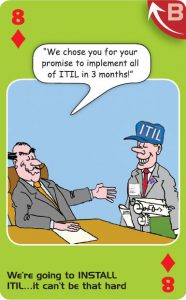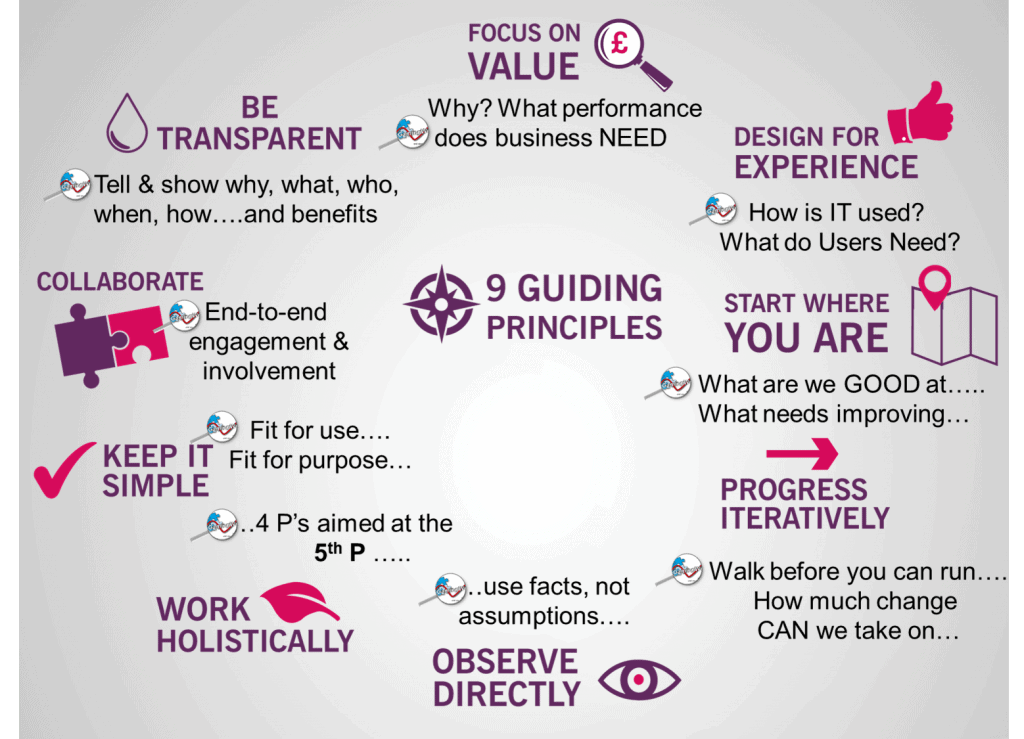‘Why is this content at the end of the conference? This should be a Keynote topic!’ – CEO
Table of Contents
ToggleABC of ICT
I was fortunate enough to have been invited to run an ‘ABC – ITIL Practitioner’ workshop at the end of a large ITSM conference using the ‘Attitude, Behavior Culture’ (ABC) cards – which is included in the ITIL Practitioner, Organizational Change Management Toolkit. My session was the last session on the last day as it wasn’t seen a sexy enough or new enough and there wasn’t enough interest from the ITSM audience.
Five minutes after starting my session a CEO and her direct report slipped into the back of the room……that is CEO. Not CIO…..at an ITSM conference!
With all this ‘Digital Transformation’ about to descend upon us I used the ABC cards to ‘surface resistance’, which both ITIL and the OCM body of knowledge stress as an important aspect of change, something equally relevant when adopting any new best practice approach such as DevOps, BRM, COBIT, LEAN, SIAM….to name but a few of the latest flavors.
Prevent or Deal with Resistence
In the workshop I also wanted to show how the ITIL practitioner guidance can help us prevent, or effectively deal with this resistance. I am sure we all recognize that the adoption and adaption of frameworks such as ITIL, DEVOPS and LEAN meets with resistance, certainly everybody that attended our stand confirmed this.
‘Resistance is a perfectly normal part of change, however the idea is not to let the resistance derail the ‘Value’ the change is trying to create’
After all ‘Value’ is what we are trying to achieve with all these frameworks…..right?! I presented our global findings that reveal that the majority of organizations still do not get the HOPED for Value.
What is a service?
At the start of my workshop I asked if anybody could explain the definition of a service according to ITIL. Nobody knew the answer (I have now asked this question to more than 15.000 ‘ITILites’ world-wide.
“Less than 5% know the answer….let alone what it means for their organization”.
The CEO said: ‘”I don’t get it. What am I missing? If they come back from ITIL training – like the people in this room, and people in my organization – how come they don’t know Value, Outcomes, Costs and Risks and what it means to their organization?….otherwise what is the point of the certification!”……there was silence.
That is exactly one of the reasons for the ITIL Practitioner I explained.
The delegates used the ABC of ICT cards to identify resistance they see, or expect to see when adopting ITIL (or any other framework for that matter). The top 5 cards chosen were:
- Never mind about following procedures…..just do what we usually do
- Everything has the highest priority according to the users
- IT has too little understanding of business impact and priority
- Process managers without any authority
- Plan, Do, Stop….no real Continual Improvement Culture
The CEO and her direct report chose the card below …explaining that this is what the CIO (No longer with the company) and an external Consulting organization had promised her! Yet she sees little return on the investment (Which could be explained by the fact that so few ‘ITILites’ seem to know the definition of a service)!!!!!

I explained that the cards chosen in this session are the top chosen cards world-wide in workshops, and have been so for the last 15 years!!!!…………..!!!! I think this deserves a number of exclamation marks. Certainly the CEO in the room gave a large ‘!?’ which prompted her to ask –
‘Why wasn’t this session a keynote session’?
The delegates were now asked to choose a top card, based upon the following: ‘Which card may be a cause for other cards, or which card causes the most negative impact on VOCR?
They were also asked to describe ‘Which ITIL Practitioner Guiding Principle(s) underpin this top card and needs to be addressed? And which stakeholders now need to display what behavior to address this’? (Because of the short duration of the workshop we focused on 3 stakeholders: The CIO, the process manager, the line manager)
Before the exercise began, I used this slide to explain the Guiding principles to the delegates, and how they fit together in the context of the ABC issues that they had selected. I suggested they all take it away, pin it up on the wall and use it as a sanity check for their own ITIL initiative.

These were their findings:
Top card chosen: Not understanding business impact and priority.
Impact: Wasted costs, potential lost value, risk to the business.
Guiding principles underpinning this: Focus on value (understand the business processes and help with the right investment mechanisms), Design for experience (understand user impact, priority, urgency & design priority and escalation mechanisms accordingly), Observe directly (If the business doesn’t know, then watch, observe, advise).
What needs to be done to solve this? Which Stakeholders need to display which behavior?
Stakeholders
CIO
- Set up effective communications and get buy-in (communications also means ‘walk-the-talk’, ‘lead by example’)
- Setting expectations – the what and the why (creating a sense of urgency and creating a vision)
- Establishing value (high level VOCR and ensuring this is translated into the 4 P’s – People, Process, Product, Partner capabilities (ensuring a holistic approach)
Process Manager
- Selling Value (communicating the value to be achieved and how the ITIL initiative will realize this)
- Training (with a focus on VOCR to be achieved using ITIL, not just theoretical ITIL training but practical AND contextual – what does it mean for us as an organization and for you as a team/individual).
- Establishing metrics/KPIs (collaboratively – internal and external)
- Managing day to day effects (with Line manager) –Is this fit-for-use, fit-for-purpose
- Accepting Line manager feedback (from teams – in terms of CSI requirements)
- End-to-end collaboration in design (4 P’s)
Line Manager
- In day to day operations supporting the process manager
- ‘walk-the-talk’ (empower the process manager)
- Policing: (rewarding desirable behavior, where necessary confronting undesirable behavior)
- Identify with teams pain points that are barriers to value. or suggestions for improvement – give feedback to process manager (Use CSI registers)
- One to one interaction with employees (make agreements on desired behaviors, focused on process related activities in relation to VOCR)
To close down the workshop I asked ‘What are you now going to go and do differently as a result of THIS session, something you hadn’t discovered in other sessions’?
The answers were:
- Go back and identify the ‘Value’ we THINK we’re trying to achieve and make sure we all understand this
- CEO: Find out where are we now, what did we get from our investment so far? We spent money on ITIL but I don’t recognize demonstrated VOCR? Find out where we are and start from there
- We are very busy – pick a small problem that is worth working on and make sure we get value (internal and external) from the effort.
- Ensure teams know the ‘WHY’, why are we doing ITIL? Get teams involved as early as possible in communication and in collaborating to improve
- Calling STOP on our corporate ITIL initiative! I am QA. This has really helped me see that we are doing it wrong? Wasting time, effort and we are at risk of failing! Then I want to re-engage and agree a shared direction forward. (Global ITSM initiative – Multi-national company)
- Go back and train people. Communicate impact, priority and urgency and explain what we are doing in line with this.
- Do this exercise with the leadership team! Or at least with the Team Leads and champions who need to lead the improvements
- Reach out to end users, discover their needs, if they can’t state them, then observe directly so we can advise, and design improvements aligned to this
- Be more transparent in choices, move more slowly with things that have impact, demonstrate this and then make the next choices.
- As a supplier ‘facilitate pain relief’ – help avoid these pitfalls and common mistakes and waste
- Was the ‘Practitioner’ materials and the exercise useful and necessary? 100% agreed. All wanted a copy of the Guiding Principle slide
- CEO: Why has this taken so long?! This one sheet explains it all, and is simple to use, we have seen so much focus on the theoretical certificates. This is what is needed, a pragmatic and practical approach.
Other related links to the ABC of ICT and how they support ITIL Practitioner:
1. ABC Customer exercise with 60 end –users (How to ENGAGE with the business and Design for Experience) – Posted on AXELOS site
2. How we used the ABC cards with board of Directors and CIO!!!! – Engage with business, focus on value, design for experience
3. And finally, read through to half way and see the CIO say this had saved him 1.2 million Euros




